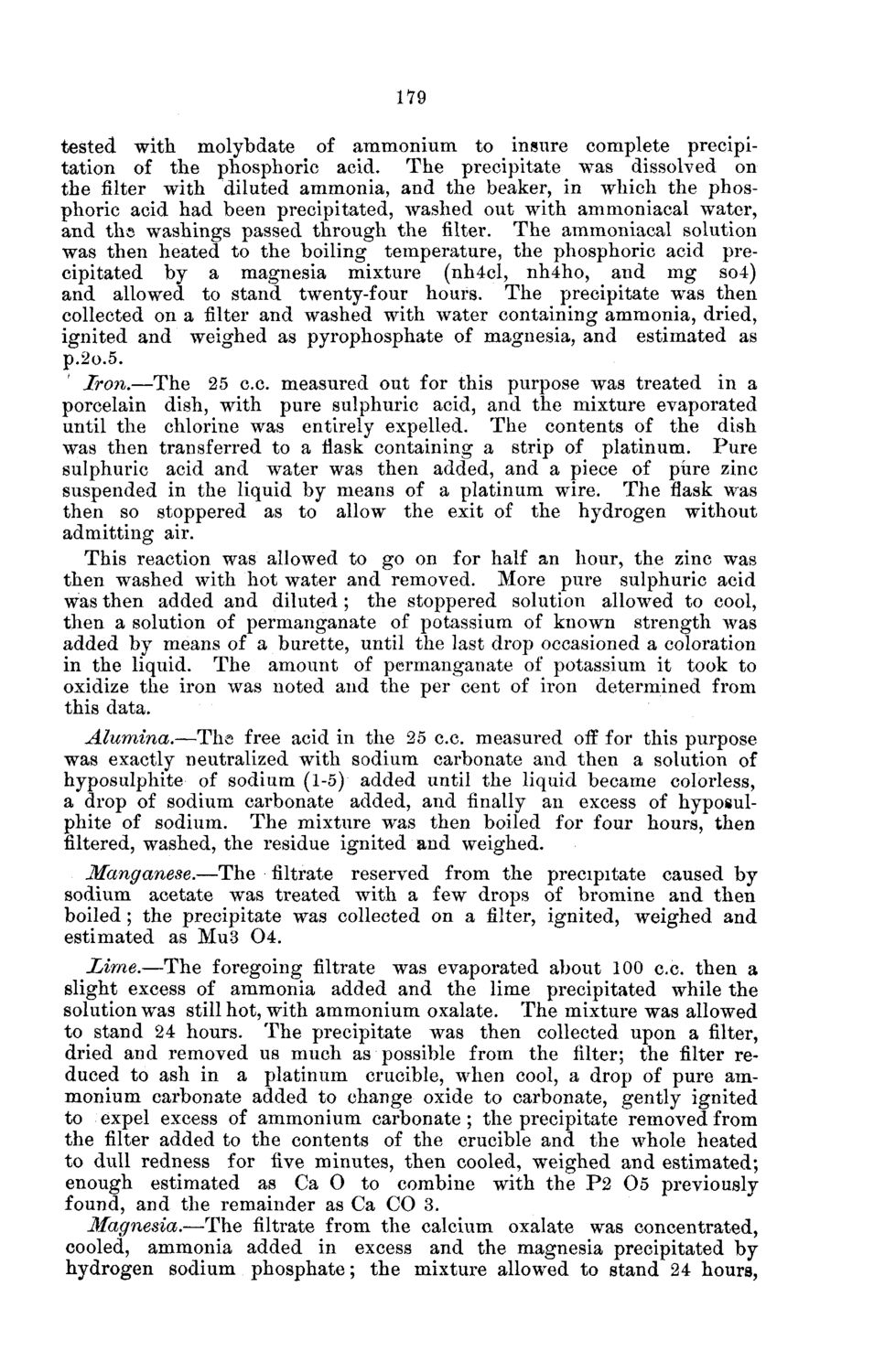| |
| |
Caption: Board of Trustees Minutes - 1878
This is a reduced-resolution page image for fast online browsing.

EXTRACTED TEXT FROM PAGE:
179 tested with molybdate of ammonium to insure complete precipitation of the phosphoric acid. T h e precipitate was dissolved on the filter with diluted ammonia, and the beaker, in which the phosphoric acid had been precipitated, washed out with ammoniacal water, and t h s washings passed through the filter. T h e ammoniacal solution was then heated to the boiling temperature, the phosphoric acid precipitated by a magnesia mixture (nh4cl, nh4ho, and mg so4) and allowed to stand twenty-four hours. The precipitate was then collected on a filter and washed with water containing ammonia, dried, ignited and weighed as pyrophosphate of magnesia, and estimated as p.2o.5. Iron.—The 25 c.c. measured out for this purpose was treated in a porcelain dish, with pure sulphuric acid, and the mixture evaporated until the chlorine was entirely expelled. The contents of the dish was then transferred to a fiask containing a strip of platinum. Pure sulphuric acid and water was then added, and a piece of pure zinc suspended in the liquid by means of a platinum wire. The flask was then so stoppered as to allow the exit of the hydrogen without admitting air. This reaction was allowed to go on for half an hour, the zinc was then washed with hot water and removed. More pure sulphuric acid was then added and diluted ; the stoppered solution allowed to cool, then a solution of permanganate of potassium of known strength was added by means of a burette, until the last drop occasioned a coloration in the liquid. The amount of permanganate of potassium it took to oxidize the iron was noted and the per cent of iron determined from this data. Alumina.—The free acid in the 25 c.c. measured off for this purpose was exactly neutralized with sodium carbonate and then a solution of hyposulphite of sodium (1-5) added until the liquid became colorless, a drop of sodium carbonate added, and finally an excess of hyposulphite of sodium. The mixture was then boiled for four hours, then filtered, washed, the residue ignited and weighed. Manganese.—The filtrate reserved from the precipitate caused by sodium acetate was treated with a few drops of bromine and then boiled ; the precipitate was collected on a filter, ignited, weighed and estimated as Mu3 0 4 . Lime.—The foregoing filtrate was evaporated about 100 c.c. then a slight excess of ammonia added and the lime precipitated while the solution was still hot, with ammonium oxalate. The mixture was allowed to stand 24 hours. The precipitate was then collected upon a filter, dried and removed us much as possible from the filter; the filter reduced to ash in a platinum crucible, when cool, a drop of pure ammonium carbonate added to change oxide to carbonate, gently ignited to expel excess of ammonium carbonate ; the precipitate removed from the filter added to the contents of the crucible and the whole heated to dull redness for five minutes, then cooled, weighed and estimated; enough estimated as Ca O to combine with the P 2 0 5 previously found, and the remainder as Ca CO 3. Magnesia.—The filtrate from the calcium oxalate was concentrated, cooled, ammonia added in excess and the magnesia precipitated by hydrogen sodium phosphate; the mixture allowed to stand 24 hours,
| |